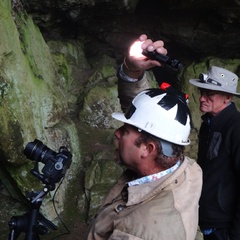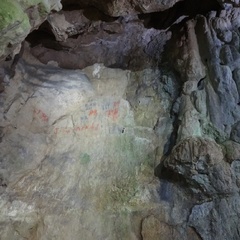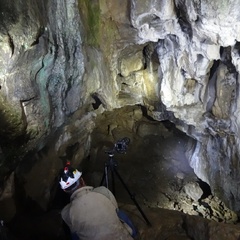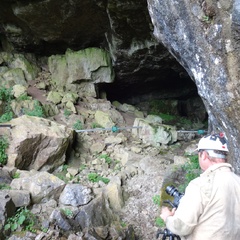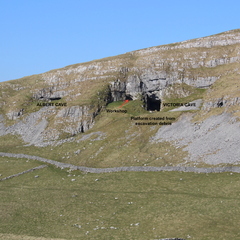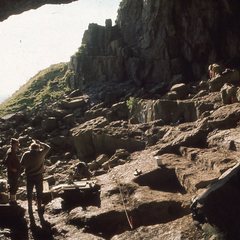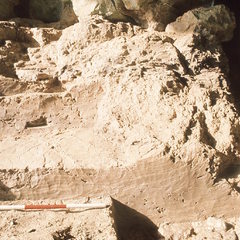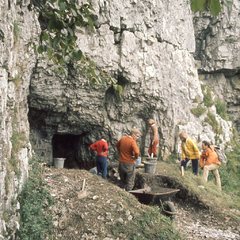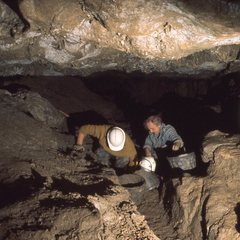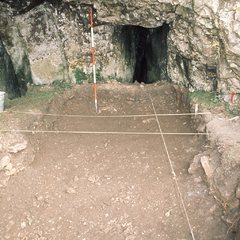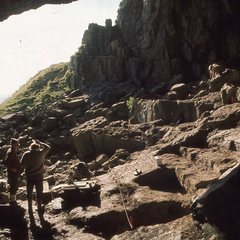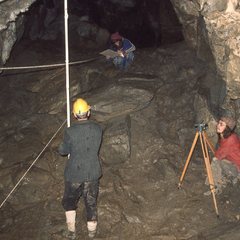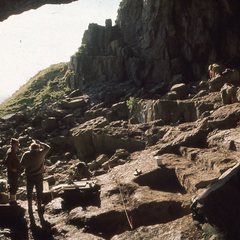- Victoria Cave
- Victoria Cave (SAM 13246) situated 439m AOD at SD839650 is the principle site within this complex of subterraneous monuments, excavated in the mid 19th and and early 20th century and containing the largest number of Romano-British artefacts recovered from a cave site in the United Kingdom (Dearne and Lord 1998). Although these early investigative works substantially modified the cave’s pre-excavation topography, a reassessment of the finds, photos and original site notebooks has enabled a reconstruction of the site’s excavation history, stratigraphy, and artefact distribution (Dearne and Lord 1998, 16). Access to the cave was restricted in the Romano British period to a narrow, potentially prospected, entrance outside Chamber A, necessitating a crawl until reaching a more spacious secondary Chamber B (ibid, 139). Numerous artefacts were deposited in areas of total darkness, with a combination of impressive natural features (stalagmite and standing water pools) and cultural modifications (a possible wall modifying the entrance into Chamber B) observed by the original excavators (ibid, 18). Focussing on the artefactual evidence, a preponderance of personal adornment and dress items (37% of the 450 copper alloy items) and Mortaria (representing 21.5% of diagnostic rim sherds) deviate substantially from what would typically be expected of a rural settlement site (ibid, 141). Butchery patterns on recovered animal bone (such as the use of heavy bladed cleavers) are also indicative of a military presence, suggesting that the intensification of Romano-British cave use was an important factor in the transition from upland ‘frontier’ to ‘militarised zone’. Brooches similar to the copper alloy spiral examples in Victoria Cave have been recovered from military contexts at both Ribchester and Newstead Forts (Oliver 2000), and all are redolent of fibulae and pendants originating from the Roman provinces of Illyricum and Dacia Trajana (Howard 2005, 33). Auxiliary troops from south–east Europe were garrisoned in the region, and historically documented practices of ritual deposition within caves in the Balkans may be a clue to the emergence and elaboration of this practice in the Dales (ibid, 53). Durig the excavation in 1870-78 faunal remains including Brown bear were recovered from deposits dating to the Upper Palaeolithic, further in the deposits fana from the Ipswichian interglacial including Hyena, Straight tusk elephant and Short nosed Rhinocerous were recovered. Sediments date back 600,000 years. Dearne, M J and Lord T C. (eds.) 1998. The Romano-British Archaeology of Victoria Cave, Settle researches into the site and its artefacts. British Archaeological Reports British Series 278 Howard, J. 2005. Cave Cults in the Yorkshire Dales? A re-assessment of Romano-British activity at Sewell’s Cave. Unpublished BSc Dissertation, University of Bradford. Oliver, A. 2000. Brooches. In, Buxton, K and Howard-Davies, C. Bremetenacum: Excavations at Roman Ribchester, 1980, 1989-90. Lancaster: Lancaster University Archaeological Unit.
3-D Models
Plan
Section
-
Section: UTU_4
- Profile VC1 and VC4 Victoria Cave (Drawn by Quatermaine 1995)
- Nigel Steel
- 20-12-2016
-
Section: UTU_5
- Profile VC2 Victoria Cave (Drawn by Quatermaine 1995)
- Nigel Steel
- 20-12-2016
-
Section: UTU_6
- Profile VC3 Victoria Cave (Drawn by Quatermaine 1995)
- Nigel Steel
- 20-12-2016
-
Section: UTU_7
- Profile VC5 Victoria Cave (Drawn by Quatermaine 1995)
- Nigel Steel
- 20-12-2016
Features
-
Feature: UTU_301
- Site of original entance outside Victoria Cave
-
Feature: UTU_302
- Intact stratigraphic deposit from the original Chamber A
-
Feature: UTU_303
- location of the end of the original passage (Chamber A) that extended over the top of the central block
-
Feature: UTU_304
- Location of the original cave entrance found and used by Michael Horner in 1837-38
-
Feature: UTU_305
- A narrow passage providing limited access to Chamber B from outside.
-
Feature: UTU_306
- Substantial deposit of cave earth in Chamber B
-
Feature: UTU_307
- Trench connecting Chamber A with Chamber B
-
Feature: UTU_308
- A cave passage containing a flowstone floor in Chamber C
-
Feature: UTU_309
- Substantial deposit of cave earth within Chamber B
-
Feature: UTU_310
- Line of a former stream passage known as Birkbeck Gallery in modern surveys
-
Feature: UTU_311
- Passage connecting Chambers A and B
-
Feature: UTU_312
- Site of trench excavated by Tiddeman in 1870-78 excavations
-
Feature: UTU_313
- Small spoil heap close to trench excavated by Alan King in 1977.
Contexts
- Brendon Wilkins 15-8-2016
